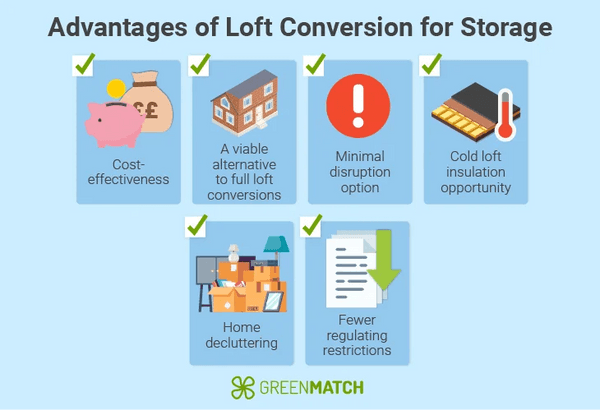Answer these simple questions and we will find you the BEST prices
Which type of solar quotes do you need?
It only takes 30 seconds
100% free with no obligation

Get Free quotes from loft conversion specialists near you

Save money by comparing quotes and choosing the most competitive offer

The service is 100% free and with no obligation
- GreenMatch
- Loft Conversion
- Loft Conversion Types
- Storage Loft Conversion
Loft Storage Conversion: A UK Guide


- Loft storage conversion offers a good home decluttering opportunity with less financial investments compared to a habitable loft.
- A basic attic renovation cost varies from £1,500–£5,000, given that you only plan the internal structural work.
- Storage loft conversions are more affordable and simpler compared to full loft conversions.
- Storage conversions provide an opportunity to add insulation, improve energy efficiency, and lower your energy bills.
When considering a loft conversion for your attic space, you may have various goals and ideas in mind. Using the additional headroom for storage is one such idea that adds significant value while requiring less financial investment.
This guide covers all the specifics you need to make an informed decision. After reading this article, you will know what loft storage conversion entails, how it’s done, and the approximate costs involved.
Are you already on the verge of searching for a contractor? You can receive up to three free quotes from trusted installers in your area tailored specifically to your project vision! Just fill out a quick 30-second form, with no obligations attached. Click below to begin!
- Describe your needs
- Get free quotes
- Choose the best offer
It only takes 30 seconds



Can a loft be converted into a storage space?
Yes, a loft storage room conversion is a possible and beneficial option for homeowners lacking additional space for household goods or small business items. You might consider this type of non-habitable loft conversion if you already have enough bedrooms and living spaces but still feel short on storage. Converting the attic into a storage area is an effective way to enhance the functionality of your existing rooms.
A storage loft conversion is possible as long as the structure can support the anticipated weight load. For example, if you plan to use the space for multiple bulky but seldom-used furniture items, the floor joists must be significantly reinforced.
When opting for a storage conversion, it’s essential to consider the square footage and specific structural features of your building. For example, if you're converting a larger attic space, as in a 40 m2 loft conversion, you might want to divide it into different functional areas. In this case, it’s best to plan ahead and determine what types of storage solutions you’ll need for each section.
Benefits of a loft conversion for storage
A loft storage room is a convenient option for several reasons. Here’s a detailed explanation of the benefits of a basic loft storage conversion beyond simply creating a space for 'keep-just-in-case' items:

Cost-effectiveness
A loft conversion storage type typically requires fewer structural modifications and minimal materials, making it a budget-friendly option. For instance, it may involve little to no plumbing, electrical work, heating systems, or extensive finishing touches. These factors make attic storage conversion simpler and more affordable than fully converting a loft into a living space.
A viable alternative to full loft conversions
A full loft conversion may not be a feasible option for homeowners due to structural limitations, planning constraints, or budget concerns. In contrast, a non-habitable loft conversion in the UK more often falls under permitted development rights. This usually implies simpler thermal insulation and accessibility planning, making compliance with building regulations a more straightforward process.
Minimal disruption option
An attic conversion storage is a quicker and less disruptive option compared to a full conversion. Since the work primarily focuses on reinforcing the floor and ensuring safe access, the construction process causes minimal disruption to your daily life. The reduced scope of work means less contractor involvement and a faster completion time, allowing you to upgrade your home without the hassle of a major renovation.
Opportunity to install insulation
Cold loft insulation means placing insulation on the floor of your attic instead of the roof. This helps keep all the heat in the storey below, ensuring your roof space remains usable without increased heating bills. Insulating a previously uninsulated loft can reduce heat loss by up to 25%, significantly improving your home's energy efficiency and reducing heating costs. This makes it a sustainable choice for both your wallet and the environment.
You also won’t need to worry about moisture as long as you plan for proper ventilation in the space. With an average air humidity in the UK varying between 40% and 50%, you may need soffit or ridge vents, breathable roofing membrane, and cross-ventilation to keep the space dry.
Home decluttering
If you often stumble upon seasonal items or rarely used belongings while simply walking through your home, a loft conversion for storage expansion may be just what you need. This is especially true if your once-cosy home has gradually transformed into a museum of old furniture alongside new purchases. Selling these sentimental items may be daunting, making a basic loft conversion for storage purposes a good investment.
Fewer regulating restrictions
Unlike full loft conversions, which are subject to more stringent planning permissions, a loft conversion to storage room is less likely to encounter strict regulations. Such projects typically require little to no significant roofline alterations, making them less invasive.
But when does a loft become a habitable room? The key differences between the two types lies in the legal standards for living and storage spaces. For instance, they differ in floor strengthening requirements, insulation, head height, ventilation types, and the availability of a permanent staircase.
These aspects require minimal external changes, meaning you are unlikely to need planning permission for the project.
However, it’s important to note that the project must still comply with general building norms. For example, the required minimum height for a loft conversion in the UK is 2.2 metres from the floor to the bottom of the ridge beam.
Predicting and considering these common requirements will safeguard you from any conversion complications.
How to convert a loft into storage room
Converting a loft into a storage room is a relatively straightforward project compared to a full loft conversion. Here’s a step-by-step guide to help you through the process:
- Calculate the required space volume: Do the items you want to remove from your living spaces consist of a few voluminous boxes? Are there old furniture pieces that need careful placement? At this point, assess your storage needs to determine the type of conversion required and whether professional services are necessary.
- Decide between professional services or DIY: If you're uncertain about structural reinforcements, electrical work, or insulation, it may be wise to hire a professional to ensure the job is done safely. However, if you're comfortable with handling the insulation and light electrical work, a DIY approach can save you some costs. To simplify your decision making, you can obtain free quotes for loft conversion and then proceed with a final choice.
- Clear and prepare the loft: Remove any existing insulation, debris, or old items from the loft to create a clean slate for the conversion.
- Reinforce the floor: Since reinforcing the joists is crucial for building attic conversion storage, make sure that new flooring can bear the weight of stored items. Typically, you can use a loft boarding conversion for this purpose, which means installing a unified board storage platform over the floor joists.
- Install loft insulation: If the loft remains uninhabitable, you can focus on cold loft insulation at the floor level. However, if the items you wish to keep require special temperature conditions, such as metal sports equipment, opt for a warm basic loft conversion storage.
- Choose a sustainable access option: For a storage conversion, you can build a staircase or add a fixed or retractable ladder. While a habitual space entails stricter regulations in this matter, non-habitable loft conversion regulations are much more flexible.
Hire a professional or DIY your loft storage conversion?
Deciding whether to take a hands-on approach or engage professionals is entirely a personal choice. As a homeowner, you have the best understanding of the scale of your project and your familiarity with DIY tasks.
This section won’t influence your decision or advocate for any particular option. However, you may find some useful considerations below that you haven’t yet thought of.

A DIY loft conversion for storage can save costs, allowing you to work at your own pace and manage the project fully. You control materials, layout, and timelines, giving you flexibility to spread the work across weekends or evenings.
- Cost savings: The main benefit of a DIY loft conversion for storage is cost savings, as you can do the work yourself at your own pace. This approach is budget-friendly and ideal for those needing extra storage without high expenses.
- You control 100% of the process: A DIY project allows you to fully control the process from start to finish. You’ll be able to make decisions regarding materials, layout, and timelines, tailoring the loft conversion to your exact needs.
- Flexibility with time: Taking on your loft conversion yourself means you can work at your own pace. You can spread the project over weekends or evenings, depending on your schedule.
- Structural risks: Improper installation of joists can lead to structural weaknesses, compromising the safety and stability of the floor below.
- Heat loss: Poor insulation can cause significant heat loss, leading to increased energy consumption and higher bills.
- Limited tools and equipment: Professionals have specialised tools that make their work quicker and more efficient. As a DIYer, you may need to buy or rent tools, raising costs and complicating the process. Lacking the right tools can also lead to difficulties and subpar results.
Hiring a professional contractor for your loft conversion provides several advantages. Their expertise allows for quick assessments of the structure and recommendations for suitable materials, ensuring quality workmanship and peace of mind with warranties and follow-up services. This is particularly beneficial when time is of the essence for family or business needs.
While hiring a contractor is typically more expensive than DIY, it helps avoid costly mistakes that could lead to redoing the project. Although DIY offers more flexibility in process and material choices, working with a contractor may limit your control over these aspects.
Given that working with contractors has fewer drawbacks and greatly increases project safety, many homeowners prefer this approach over attempting a DIY loft conversion. You can also reduce risks to your home and budget by getting no-obligation quotes from installers. This way, you can learn the specifics and requirements of your renovation without any upfront payments.
Does it sound like a good deal for you? You can reinforce your confidence now by receiving up to 3 free quotes from professional installers in your region. Click below to begin!
- Describe your needs
- Get free quotes
- Choose the best offer
It only takes 30 seconds



How much does a loft storage conversion cost?
A basic attic renovation cost varies from £1,500 to £5,000, given that you only plan the internal structural work with no significant changes to the roofline.
If you also want to add more light and ventilation to the place, you can consider a Velux conversion, which costs approximately £1,500 to £5,000.
The final budget will depend on the materials and the decision of whether or not you are hiring contractors.
The cost of flooring per m2 may be between £20 and £100, while insulation costs require about £1000.
Loft conversion storage ideas
To precisely decide on what a non-habitable loft conversion in the UK can look like, you need to consider your home architecture type and the purpose of your storage place. How much roof space do you already have in your attic? What items will you keep there? Are your rarely used belongings small items or bulky furniture pieces?
If you are unsure which storage option to choose for your answer to these questions, we have some sustainable ideas for you below.
Loft eaves storage

A loft eaves storage, is a custom solution designed to fit the specific dimensions of your loft space. For instance, the storage cupboards can be fitted under low roof pitches and limited overall square footage. They are ideal for organising seasonal clothing, sports equipment, books, or other medium-sized belongings.
With features like adjustable shelvings, sliding doors, and pop-out drawers, this storage type ensures that your loft remains clutter-free.
If you have some furniture pieces that do not serve you and your interior, you may repurpose them for a convenient attic storage solution.
For example, an old dresser can be transformed into a storage unit by removing the mirror and using the drawers to organise seasonal clothing. Wooden pallets can be upcycled into open shelving units, and a vintage trunk can collect holiday decorations.
Modular storage units

Modular storage bins are flexible and adaptable, allowing you to reconfigure the layout as your storage needs change. Whether you need shelves, drawers, or a combination of both, modular units can create a dynamic and organised storage environment tailored to your lifestyle.
Built-in attic wardrobe

For those having big families or collecting fashionable clothing, making a storage for all the belongings is a challenging puzzle. You may have some extra bedding sets in case the guests come or need to collect everyone’s seasonal shoes in one space, clean and organised.
Built-in attic wardrobes can utilise vertical space effectively, often reaching up to the eaves of the roof. As they suit the specific angles of your attic, this solution maximises storage capacity in an area that might otherwise be underutilised.
Are you ready to take another step into upgrading your attic space? You can benefit from tailored quotes from professional installers for your specific project with no strings attached. Fill out a quick form to get free clarifications for your project! Click below to begin!
- Describe your needs
- Get free quotes
- Choose the best offer
It only takes 30 seconds



FAQ
Yes, you can convert your loft into a storage room, as long as it meets basic building safety regulations.
Generally, loft storage conversions do not require planning permission, provided there are no significant changes to the roofline.
You can obtain up to three free quotes from professional installers in your area. This way, you won’t need to spend time searching and accessing their reliability.

Tania is an experienced writer who is passionate about addressing environmental issues through her work. Her writing aims to shed light on critical environmental challenges and advocate for sustainable solutions.
We strive to connect our customers with the right product and supplier. Would you like to be part of GreenMatch?

